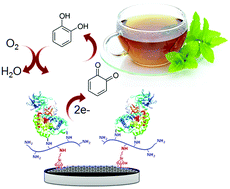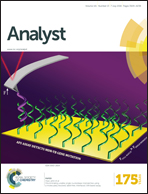Novel reduced graphene oxide–glycol chitosan nanohybrid for the assembly of an amperometric enzyme biosensor for phenols†
Abstract
A novel water-soluble graphene derivative was prepared from graphene oxide via a two-step modification approach. Graphene oxide was first functionalised with reactive epoxy groups by covalent modification with (3-glycidyloxypropyl)trimethoxysilane and further cross-linked with glycol chitosan. This graphene derivative was characterized using different microscopy and physicochemical methods and employed as a coating material for a glassy carbon electrode. The nanostructured surface was used as a support for the covalent immobilization of the enzyme laccase through cross-linking with glutaraldehyde. The enzyme electrode was tested for the amperometric detection of different phenolic compounds, which displayed excellent analytical behaviour toward catechol with a linear range of response from 200 nM to 15 μM, sensitivity of 93 mA M−1 cm−2, and low detection limit of 76 nM. The enzyme biosensor showed high stability when stored at 4 °C under dry conditions and was successfully employed to quantify the total phenolic compounds in commercial herbal tea samples.

- This article is part of the themed collection: Carbon and graphene in analytical science

 Please wait while we load your content...
Please wait while we load your content...